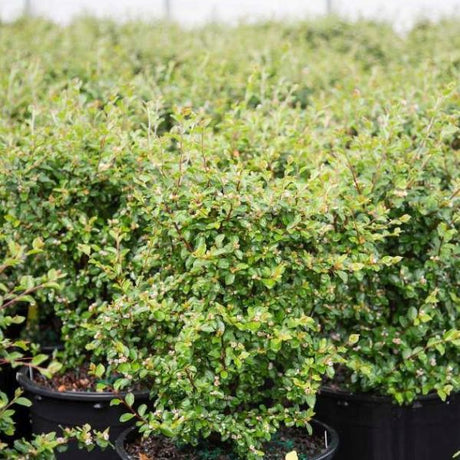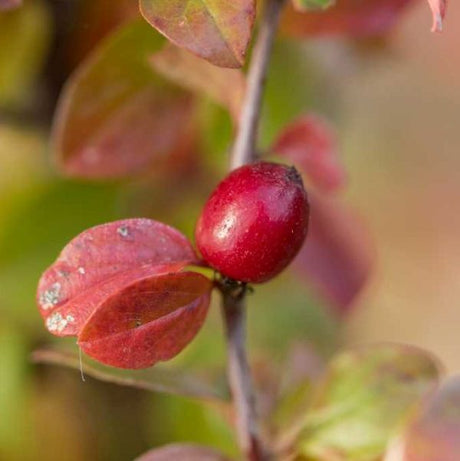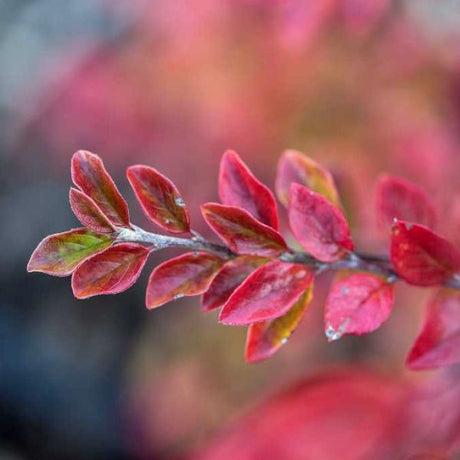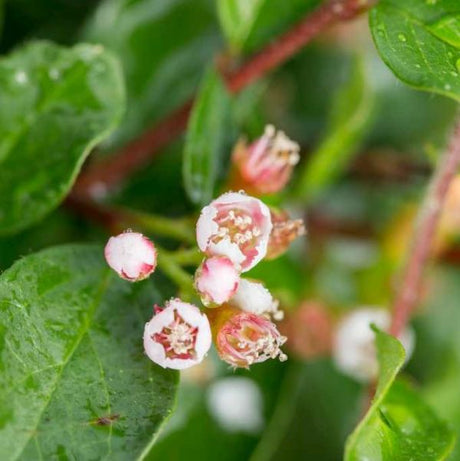- Sold outUp to 9% off
- Sold out
Cotoneaster acutifolius var. lucidus
Regular price From $2167Unit price /Unavailable
Cotoneaster Plants for Sale at Nature Hills Nursery
Robust with bird-friendly berries, the cotoneaster shrub delivers a world of value. You’ll find a striking variety of cotoneaster plants for sale right here at Nature Hills Nursery.

This wide-ranging family includes tall privacy shrubs and showy ground-covering plants.
We offer evergreen, semi-evergreen and deciduous varieties. Cotoneaster is incredibly rugged and makes a marvelous addition to low-maintenance gardens.
We take pride in our collection of Cotoneaster shrubs. According to the Chicago Botanical Garden, there are approximately 90 species, or types of Cotoneaster. Make your garden sing year-round with their help.
Cotoneaster shrubs deliver cute spring blooms, beautiful berries, fine-textured foliage and wonderfully organic form with cascading branches. These are important wildlife plants for pollinators and songbirds.
Cotoneasters in the United States
These low-maintenance, sculptural shrubs are in the Rose family. Cotoneaster is related to Hawthorne and Photinia, and it brings a wonderfully rounded, arched form.

Don't worry, it only looks dramatic. These workhorses are tough customers that need little care once they are established in your landscape.
You'll hear cotoneaster name pronounced "Cotton Easter" but the botanical name "Koh Toe Knee Aster" implies they resemble Flowering Quince shrubs. Why not include them both in a lawn planting bed for ornamental spring blooms, showy berries and fall color?
Use one as a specimen in containers or in the ground. Or keep a mass planting to showcase their lyrical branch structure.
These Eurasian natives can be safely grown in most parts of the continental United States. With forms from creepers to trees, charming cotoneaster offers plenty of interest year-round.
Cotoneaster Blooms Support Butterflies and Pollinators
In spring, gracefully arching branches are abloom with tiny white to rose-pink flowers. While sweet to look at, the true value lies in their nectar.
Butterflies will visit your plants, and the single, five-petal flowers will be richly appreciated by the honeybees in your area. Cotoneaster provides nectar and shelter for many beneficial insects within the petite, lustrous, smooth leaves.
Cotoneaster’s Nutritious Berries Feed Birds
Routinely listed as a bird-friendly option, Cotoneaster shrub branches are laden with berries that attract Cedar Waxwings and Robins. Wildlife love the fruit produced by these plants, which are technically called pomes — like tiny round apples.

Depending on what part of the country you live in, Cotoneaster may be a favorite treat for your local bird populations. This is especially true in late winter, when food is scarce.
They also provide good cover for smaller species and smaller birds, like Goldfinches. Keep a feeder nearby to offer convenient access.
In certain climates, Cotoneaster bushes might perform too well, and the berries are dispersed by birds. That's why we use Plant Sentry™ to block the shipment of regulated plants to regions where certain plant materials are prohibited. We follow every federal and state regulation to the letter.
If we can safely ship Cotoneaster shrubs to you, you can safely grow it in your local microclimate. The birds will thank you.
Layer Low-Growing Cotoneaster as a Groundcover

Glorious Cranberry Cotoneaster is a bird-friendly choice with outrageous color. The birds snap up the lively red berries for their supper starting in early autumn through late winter.
Cotoneaster bushes are commonly used in areas where soils are tough and irregular. They are planted on steep embankments to hold soils from eroding.
Turn a dangerous slope into a bold garden feature with evergreen Coral Beauty Cotoneaster shrub. Mass plant these fast-growing groundcover plants in staggered rows for a fast fill.
The Tom Thumb Cotoneaster bush is a very popular natural dwarf. Keep them in containers or rock gardens, or fill bare ground with their vibrant fall foliage.
Easy to Grow Cotoneaster Hedges
Nature Hills Nursery also sells tough, easy-care shrub-form Cotoneaster. There might not be an easier hedge to establish and maintain.
The cotoneaster hedge tends to be deer resistant and drought tolerant after their root systems are established in your soil. They grow fast, turning into valuable landscape assets that are loaded with charm.
Cold-hardy Peking Cotoneaster brings so many ornamental attributes to your landscape. Create structure and add privacy, along with spring bloom, lustrous summer leaves, incredible fall color and blue-black berries.
Another easy care option is the famed Hedge Cotoneaster. With fiery fall color, these high-performance beauties look great all season long.
Prune these to shape after the small pink and white flowers are done, or leave them au natural. They'll develop into a pretty, upright shrub with glossy green leaves and spreading branches.
Planting and Care Tips for Cotoneaster
You can order plants any time of year at Nature Hills Nursery. We'll hold your order until the time is right for planting in your area.
Study the Plant Highlights on every product page to get the details on individual cotoneaster plants for sale. You'll want to give them their preferred sun exposure and soil type to achieve great results.
Learn How to Grow Healthy Plants >>
Dig your planting hole twice as wide as the root system, but no deeper. Cotoneaster shrubs generally prefer well-drained soil and will not appreciate being buried too deeply.
For mass plantings, stagger rows in a checkerboard planting pattern to cover the space. Measure 1 foot less than the smallest number given on the mature spread to get a solid fill.
Mulch between plants, and keep newly established mass plantings weeded. You'll want to manage your mass planting to keep them looking their best.
Provide careful water the first season. Thereafter, we do recommend applying supplemental water during extended droughts.
How to Prune Cotoneaster
The best way to prune a Cotoneaster? Give it plenty of room to reach its full mature height and spread to develop its lovely growth habit.
Prune these herringbone-patterned branches with an eye to maintain the overall arched shape. Remove dead wood at ground level, or clip back to a living main branch.
Avoid header cuts to shorten. Rather, look for ways to clip long branches back into the canopy, streamlining the branches all the way back to a larger structure branch.
Enjoy the durability and ease of living with planted cotoneaster shrubs. Beneficial pollinators and birds will appreciate this lovely choice. And we appreciate your business. Ever since we established our online nursery in 2001, our goal has been help customers grow happy with high-quality plant materials shipped across North America.
Check out the variety of cotoneaster plants for sale at Nature Hills Nursery, then place your order today.

FAQ's for Buying Cotoneaster Bushes Online
What growing conditions do Cotoneaster shrubs prefer?
What growing conditions do Cotoneaster shrubs prefer?
Cotoneaster plants thrive in full sun to partial shade and prefer well-drained soil. Once established, these hardy shrubs are drought-tolerant and adaptable to a wide range of soil types, making them excellent for low-maintenance landscapes, slopes, and erosion control.
Are Cotoneaster bushes good for wildlife and pollinators?
Are Cotoneaster bushes good for wildlife and pollinators?
Yes, Cotoneaster shrubs are highly beneficial for wildlife. Their small spring flowers attract pollinators like bees and butterflies, while the bright red or black berries provide essential food for birds, especially during the late fall and winter months.
How do you prune Cotoneaster shrubs properly?
How do you prune Cotoneaster shrubs properly?
To maintain their graceful arching shape, prune Cotoneaster bushes in early spring by removing dead, damaged, or crossing branches. Avoid heavy pruning; instead, selectively thin branches by cutting them back to a larger branch. This preserves the natural herringbone pattern and ensures a healthy, ornamental form.
Can Cotoneaster be used as a groundcover or hedge?
Can Cotoneaster be used as a groundcover or hedge?
Absolutely. Low-growing varieties like Cranberry Cotoneaster are ideal for groundcover and controlling erosion on slopes. Taller types like Hedge Cotoneaster and Peking Cotoneaster make excellent privacy hedges, offering dense foliage, ornamental berries, and vibrant fall color with minimal upkeep.
Is Cotoneaster deer-resistant and easy to care for?
Is Cotoneaster deer-resistant and easy to care for?
Yes, most Cotoneaster varieties are considered deer-resistant and require little care once established. These shrubs are tolerant of drought, heat, and poor soil, making them a reliable choice for busy gardeners seeking ornamental beauty and wildlife value without high maintenance.












